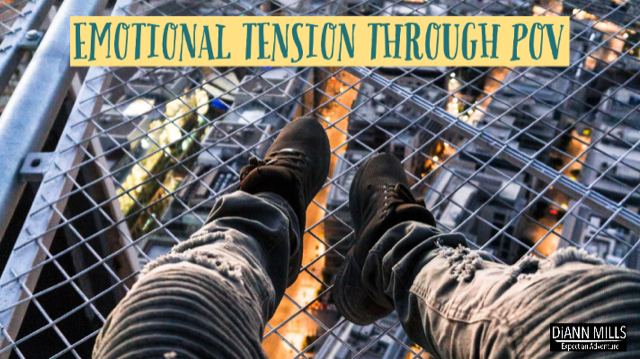Varying degrees of point of view (POV) allows the writer to control emotional distance between the reader and the character. The distance is set in direct relationship to the role the character plays in the story, the mood, and voice.
The POV character takes the spotlight and has the most to lose or the highest stakes. Every word in the scene and the subsequent internal reaction is filtered through the character’s sensory perception and life experiences.
The mood of the scene is the writer’s GPS. Adjusting the emotional distance creates a level of emotional tension that parallels the mode of the story.
The distance the writer chooses for the character to internalize what previously occurred varies per:
1. The action prompting the character’s reaction.
2. The traits assigned to the character, guiding how the character
views life in a range of introversion to extroversion.
3. The character’s fears and past wounds.
4. The character’s goal or problem to solve.
5. The character’s knowledge of the incident.
6. The ability of the character to honestly process information.
Some scenes require a close emotional distance, such as a character’s revelation or facing a hard truth. Other scenes may have more impact with greater distances such as a character who doesn’t have all the information. An unstable character, especially one who is insensitive, evil, or selfish, can set the stage for a gripping scene.

First Person
With first-person point of view, everything is told from the narrator’s viewpoint of “I.” The advantage is intimacy. It’s easy to believe what the character says, thinks, does, and experiences—like a friend telling you about an event or reading someone else’s diary. Multiple first-person POVs with varying degrees of emotional distance are powerful stories.
The following are examples of first-person POV, from distant to close. Note how each sentence brings the character closer to the reader.
-
- I saw heavy traffic from my office window.
- I saw more trucks than cars in the heavy traffic.
- Julie’s BMW emerged from the heavy traffic like a silver bullet, and I held my breath until she exited safely.
-
- I followed the woman through the mall.
- I followed the young woman dressed in jeans through the mall.
- I followed the young woman dressed in jeans and red stilettos through the mall and labeled her as my next victim.
Multiple first person is becoming more prevalent in recently published novels.
Third Person
In third person, the writer uses “he,” “she,” or the character’s name.
Third person is the most prevalent among writers. Multiple third-person POVs give the writer a variety of perspectives from which to show the story.
The following are examples of third person, from distant to close. Again, note how each sentence brings the character closer to the reader.
-
- He saw heavy traffic from his office window.
- He saw more trucks than cars in the heavy traffic.
- Julie’s BMW emerged from the heavy traffic like a silver bullet, and he held his breath until she exited safely.
-
- Jean agreed to go to the baseball game.
- Jean agreed to go to the baseball game although the opposing team was favored.
- Jean feared the home team might lose again since the opposing team’s pitcher had pitched three straight shutouts.
Look at the story you’re reading or writing. Do you see where varying the emotional distance adds dimension to your story?

